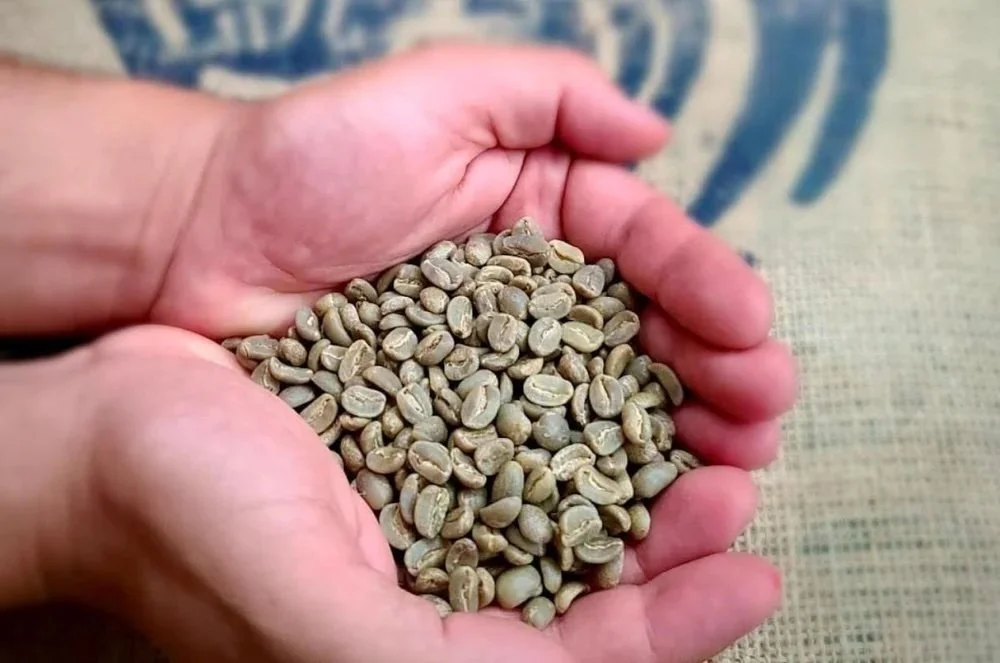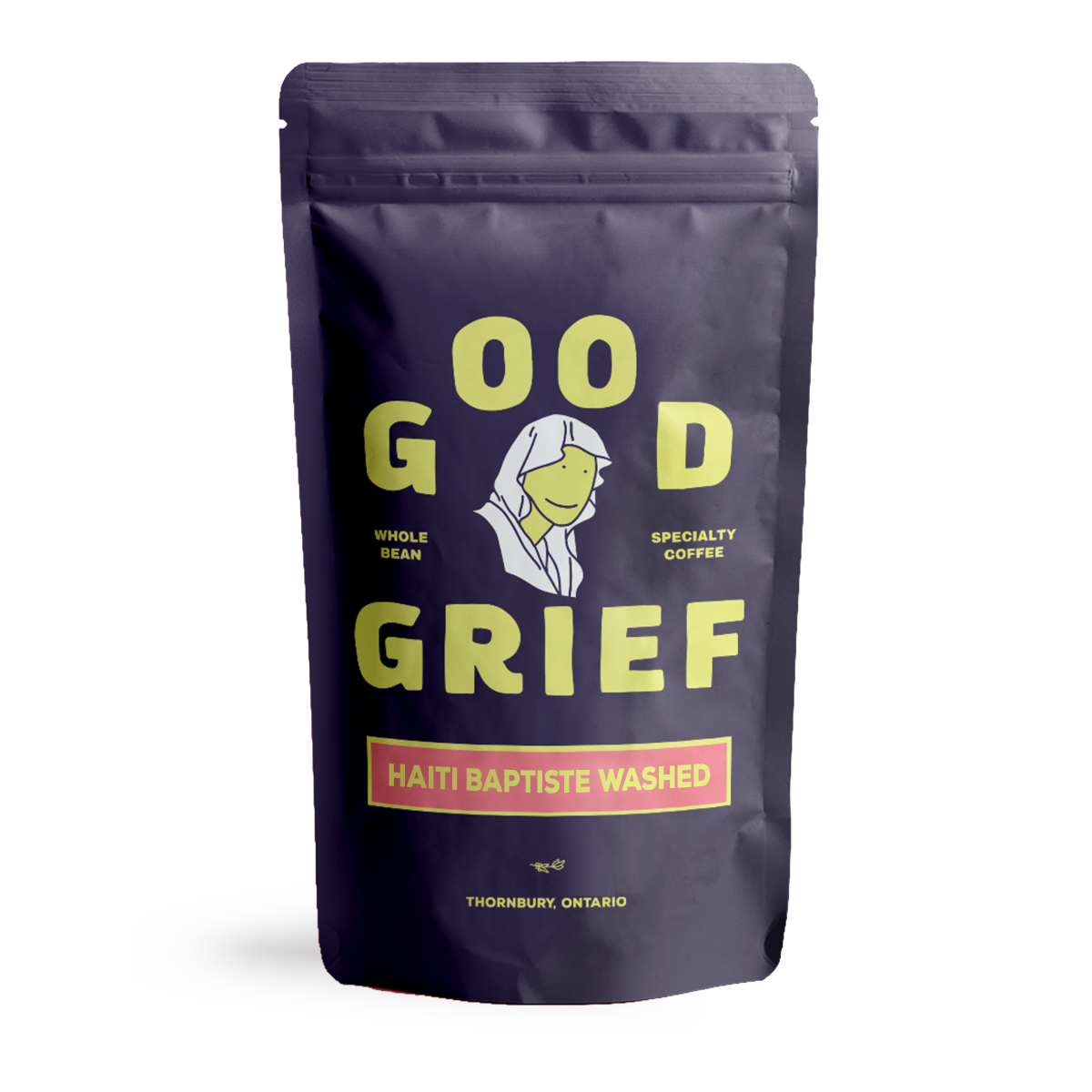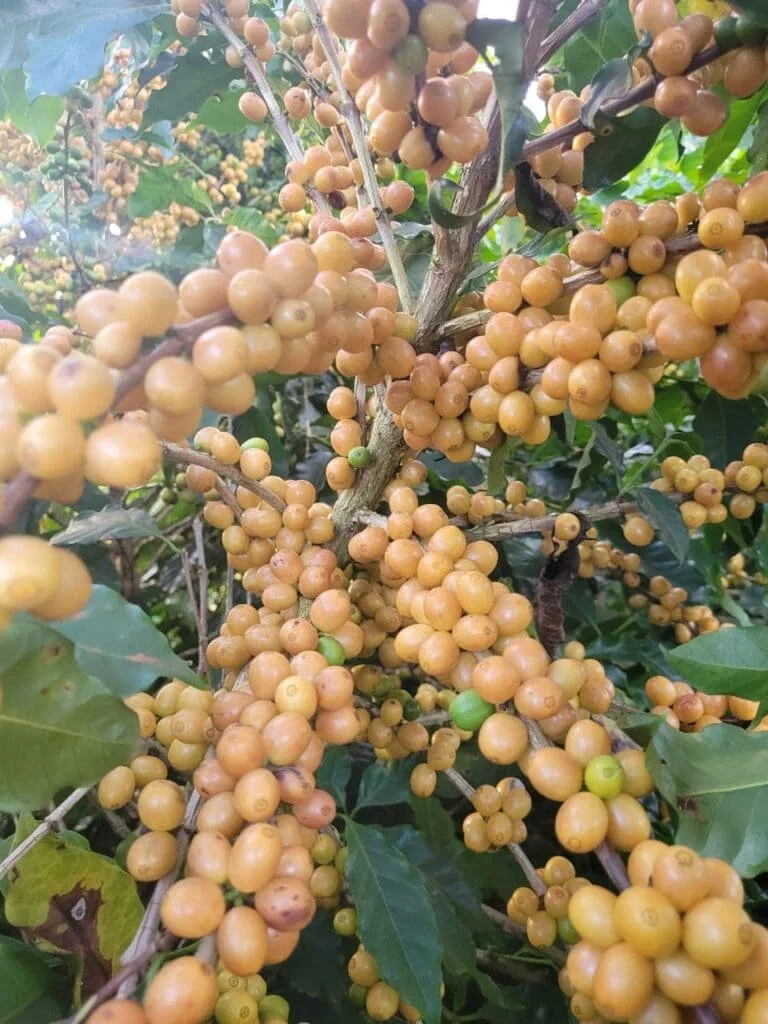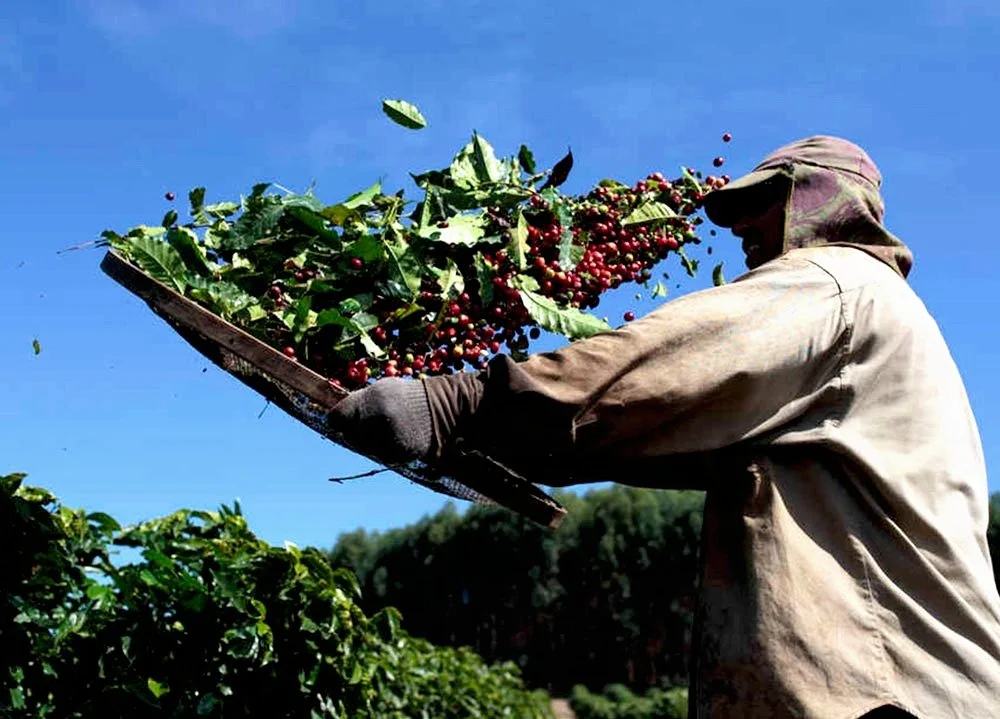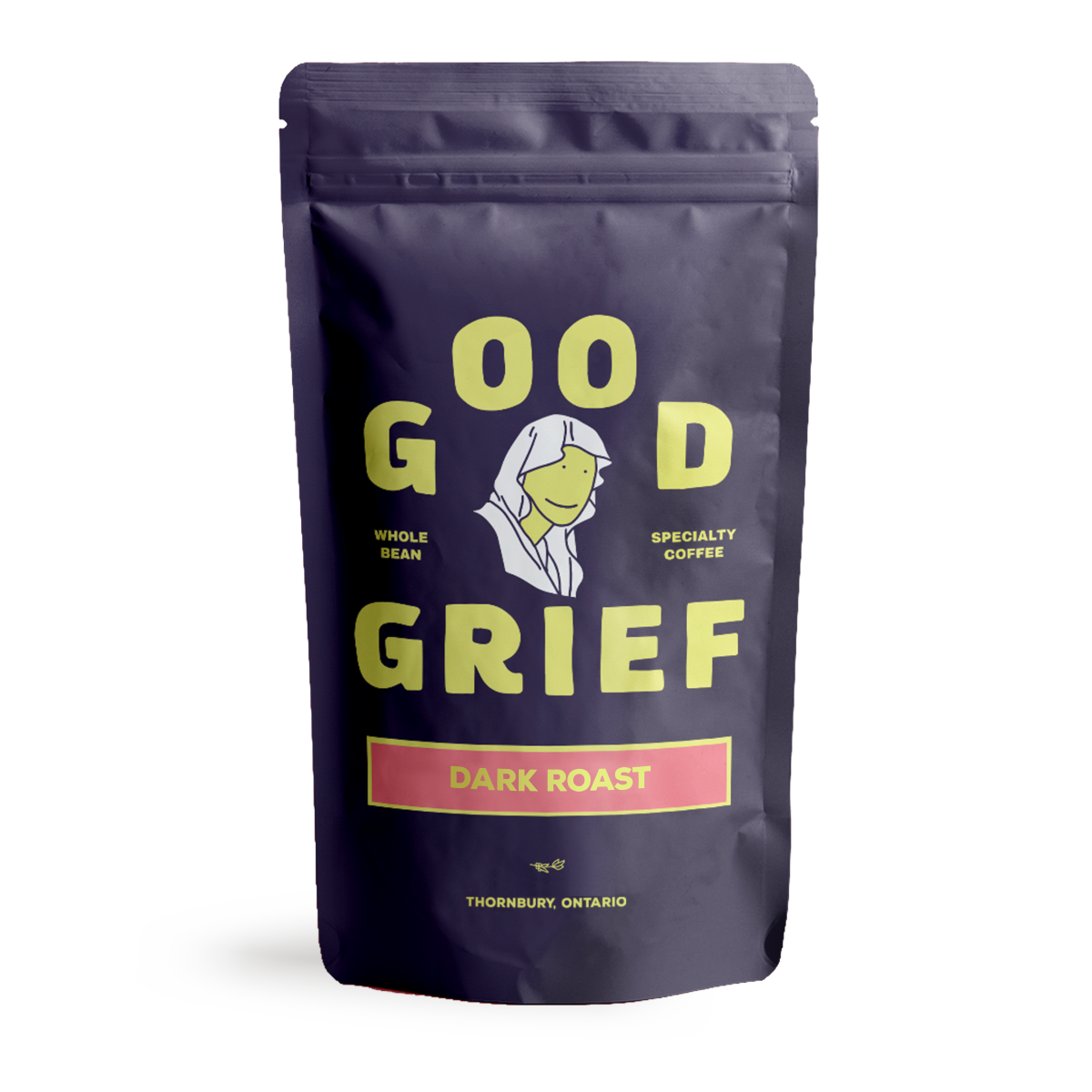our coffees
Introducing Baptiste, our specialty coffee from Kok Ki Chante in the Kolen region, designed for customers looking for unique, ethically sourced options. This fully washed Caturra coffee captures the complexity and depth of Haiti’s coffee tradition, providing a roby and captivating flavour profile.
Baptiste coffee delivers a full bodies, creamy experience with notes of candied apple and Fudgesicle and hints of crème brulee. The blend of spices adds richness while the floral acidity and quick chocolatey aftertaste make it an excellent choice for espresso, French press, and drip brewing methods. Each batch reflects the care and traditional craftsmanship involved in producing the exceptional Haitian coffee.
Haiti’s Baptiste coffee is a unique find, grown by dedicated Haitian farmers in the rich soils of the Baptiste region. Cultivated at elevations between 1200-1400 masi, this coffee benefits from nutrient rich soils, abundant rainfall, and a balanced tropical climate. The wash process used in its production enhances the natural sweetness and clarity of flavours, delivering a high-quality cup that speaks to the dedication of its farmers.
Similar to Jamaica, Haiti also has a unique micro-climate that benefits the production of coffee; it is also the most mountainous country in the Caribbean. The coffee has a distinctive and unforgettable taste due to its healthy, volcanic, and rich soils. The coffee’s Ethiopian roots heavily influence the traditions of the Haitian farmers when cultivating, making the coffee refined and rich in flavour.
Kok Ki Chante is a non-profit and proud leader in Haiti’s specialty coffee sector, focusing on sustainable practices and supporting local farmers. Through strong community ties, Kok Ki Chante brings uniquely vibrant, high-quality Haitian coffee to the world.
This coffee was processed at Jorge Vasquéz Ureña’s Roble Negro micromill in the town of Aserrí in Costa Rica’s Tarrazú region. The micromill partners with local coffee growers like Alfredo Monge Garbanzo to produce quality, traceable lots and to help facilitate access to international markets.
Coffee producer Alfredo Monge began planting coffee at his Finca El Cedral in Tarbaca, Aserrí, Costa Rica in 2015. Alfredo’s history with coffee dates back to the 1970s, and today El Cedral is just one of the properties he owns and oversees.
As a producer, Alfredo’s main goal is to produce high quality coffee and to continue improving each year. To achieve this, he has been implementing certain practices at his farm such as applying calcium sulfate as a natural fungicide for his plants. Currently, Alfredo processes all of his coffee at the Roble Negro mill.
The Roble Negro mill is located at Finca Cedral Alto in Tarbaca, Aserrí, Costa Rica. The mill was founded in November 2019, initially only fitted with drying beds and patios. The team made several important investments in the mill in 2020, growing the infrastructure to be able to process Natural, Honey, and Washed coffees.
The Roble Negro mill is well-known for its high-quality standards and thoughtful sustainability practices. Operations at the mill aim to reduce the use of nonrenewable resources like water and electricity, repurpose waste products into natural fertilizers, and even ensure that the GrainPro used for packing and shipping coffee is reused or recycled by the mill’s global partners.
This lot of Venecia coffee underwent Washed processing at Roble Negro. Harvested cherries were sorted via floatation before being pulped. The pulped coffee is then fermented in tanks for 36–40 hours. The fermented coffee was then washed to remove any remaining mucilage before being moved to raised drying beds. The washed coffee was dried for 6–8 days to reach 11% humidity. Dried coffee was rested in the mill’s warehouse for at least two months before being milled and packaged for export.
The Tarrazú region lies in the high mountains of the southern Pacific region south of Costa Rica’s capital city of San Jose and is one of the most densely planted high altitude regions in Central America, with many farms at or above 2000 meters above sea level. It is locally known as “Zona de Los Santos” for the number of towns with “San” or “Santa” in their names.
Tarrazú’s climate is characterized by two well-defined seasons; a rainy season lasting seven months (May through November) and a dry season (December through April). This encourages uniform coffee blossoming. On average, precipitation is between 2,400 millimeters (94.5 inches) per year, with an average annual temperature of 19°C (66.2°F).
The fertile, volcanic soils and rolling mountainsides of Tarrazu are well-suited for agriculture, and smallholders grow bananas, avocado, and citrus as well as coffee on properties passed between generations. The spirit of community and family is strong in Tarrazu, with producers caring for their land with pride. Many farms in Tarrazú include primary forest and some degree of shade trees interspersed with coffee and producers take care to protect the natural water sources that spring up from the mountainsides.
Bom Jardim Farm reflects the passion and perseverance of its owner, Leandro Henrique Gomes, who carries on a family legacy rooted in coffee cultivation. Leandro’s journey began in 2011 when he took over the management of coffee production previously started by his father, Ernandes Delfino Gomes, on a family farm in the Esmeril region.
In 2017, Leandro partnered with his friend Ronianderson Tadeu de Souza to establish Bom Jardim Farm in the Patrocínio municipality of Minas Gerais. Starting with annual crops like soybeans, sorghum, and corn, they transitioned to coffee cultivation, planting their first 19 hectares in 2017, followed by expansions in 2018 and 2020.
The farm spans 120 hectares, with 73 hectares dedicated to coffee cultivation. Agronomic practices such as soil fertility corrections and fertilization based on detailed analyses ensure sustainable production while maintaining a balance between the soil, plants, and the environment.
Leandro’s unwavering dedication, supported by his family, has allowed Bom Jardim Farm to thrive despite early challenges, including securing financial resources and infrastructure. Today, the farm represents resilience and a commitment to producing high-quality coffee while embracing sustainability.
The Cerrado Mineiro region, located in northwest Minas Gerais, is recognized globally for its high-quality coffee production. It became the first Protected Geographical Indication in Brazil in 2005, later achieving full Designation of Origin in 2013. The region’s distinct seasons—a hot, wet summer and a dry winter—offer ideal conditions for coffee cultivation and drying.
Cerrado coffee farms are characterized by their entrepreneurial spirit, with many producers being second- or third-generation farmers. These farmers invest in advanced agronomic techniques and sustainable practices, contributing to consistent quality and innovative approaches to coffee production.
Elevations ranging from 800 to 1,300 masl and healthy soils, cultivated with calcium to counteract natural acidity, enhance Cerrado’s reputation as a hub for exceptional coffee.
Coffees from this region are celebrated for their rich chocolate notes, big body, and velvety texture, making them a favorite among espresso enthusiasts. With an average production of 35 bags per hectare, the 4,500 farmers in the region produce around 6 million bags of coffee annually.
This bean is perfect for espresso and boasts traditional flavours cocoa powder, liquorice root and plum.
Serras de Minas is a perfect example of a traditional balanced Brazilian coffee. It carries the traditional profile of a Brazil coffee with nutty and chocolatey notes, but much more elevated and with added complexity that exceeds most Brazil coffees. In this coffee we find a rich cholate note, dried citrus and a pleasant nutty finish. This is a fully traceable Swiss Water Process decaf bean, produced in Brazil and imported by Catalogue Coffee in Toronto. It is made from a blend of coffees from producers Luiza Macedo, William Cesar Gomes, brothers Márcio Custódio and Izonel Junior and Fazenda CETEC.
From an early age, William Cesar Gomes learned the craft of cultivation from watching his parents and older brothers. There was a time when the family crops ended but when the growing life resumed in 2017, William joined in to plant his first crop. Drought and pests made that initial plunge a challenge, but over time, William has successfully added more crops and more experience to his resume as his production effort has grown in the pursuit of high-quality coffee.
From humble beginnings, brothers Márcio Custódio and Izonel Junior discovered their passion for coffee working as pickers before dedicating themselves to their studies. After becoming university professors, they pledged to open their own technical school: several years later, the CEDEC Technological Center became a reality. Located in the city of Lavras, in the south of Minas Gerais, CEDEC aimed to provide young people in need with the possibility to study and improve their quality of life. Ten years after forming CEDEC, and having trained more than 5,000 youths, Márcio and Izonel decided it was time to make good on their dream of returning to the land and purchased a small farm in the tiny town of Itumirim (which means “small waterfall,” in tribute to the dozens of scenic waterfalls the area is known for). In a tragic twist of fate, Izonel died not long after the farm’s purchase. Márcio thought of selling but instead opted to pursue the brothers’ childhood passion, naming the property Fazenda CETEC in honour of the school that provided them with the opportunity to begin again as producers of beautiful coffee.
Through the years, Fazenda CETEC has focused on providing a respectful and safe environment for workers (CEDEC does not employ children based on the premise a child’s place is in school). Committed to the well-being of the farm and the springs and forests it connects to, CETEC keeps water use in its processes to a minimum and integrates signalgrass (Brachiaria) to help prevent soil erosion and reduce the need for herbicide and chemical fertilizers to keep weeds and pests at bay. The grass is placed under coffee trees to create a natural organic buffer.
An agronomist, producer Luiza Macedo has dedicated herself to the pursuit of studying coffee production. She has a master’s degree in coffee nutrition and physiology and is now in the throes of obtaining a PhD. Luiza is a founding partner of the company ""Conhecimento Agro” – aimed at increasing producers’ autonomy by providing a bridge between research, theory and practice through the provision of online courses and consulting. Luiza is currently the deputy director of research at the Brazilian chapter of IWCA (Alianca Internacional das Mulheres, do Café).
This isn’t a regular Dark Roast, it’s a cool Dark Roast.
Our ode to dark roast is a little bit smoky, a lot a bit tasty, and has all the integrity and flavour you’ve come to expect from a Good Grief coffee. A blend of seasonal beans, the Dark Roast will satisfy drinkers without leaving the bitterness of a traditional French Roast behind. It’s perfectly balanced notes of molasses, baking spice, and caramel make it suitable for both filter coffee and espresso, and everything in between. Although roasted a bit darker than our standard coffee, the nuance of the beans still shines through giving the drinker a delicious mouthful of caffeinated goodness, sip after sip.


